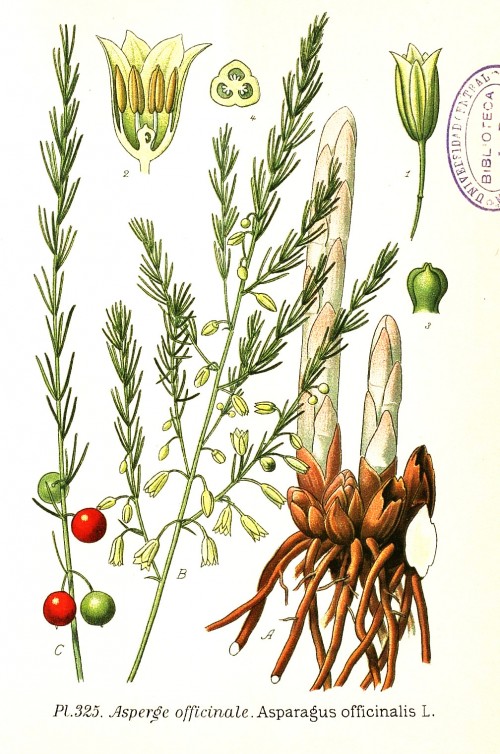Dies ist eine alte Version des Dokuments!
Asparagus officinalis L. - syn.Asparagus caspius Hohen.; Asparagus longifolius Fisch. ex Steud.; Asparagus polyphyllus Steven ex Ledeb. - Asparagaceae - (garden) asparagus, (Garten-) Spargel
Perennial herb, native to Europe and Western Asia; inflorescences developing after cladodes; flowers of both sexes solitary of in clusters of 2-4, male flowers yellowish green, campanulate, 5-6 mm, female flowers perianth ca.3mm; fruit a red berry 7-8mm in diam.
http://www.efloras.org/florataxon.aspx?flora_id=2&taxon_id=200027573
„The „leaves“ are in fact needle-like cladodes (modified stems) in the axils of scale leaves… Asparagus has been used as a vegetable and medicine, owing to its delicate flavour, diuretic properties, and more. It is pictured as an offering on an Egyptian frieze dating to 3000 BC.“
http://en.wikipedia.org/wiki/Asparagus
„The mephitic nature of these asparagus-related odorous urines was (and still is) markedly reminiscent of certain pungent sulfur-containing compounds and, accordingly, the offensive substance was initially identified as methanethiol following its precipitation as silver and mercury mercaptides. The actual techniques used for this isolation, however, were lengthy and harsh and undoubtedly degraded other sulfur compounds, if present, into methanethiol… More recent studies have suggested that there are at least three major sulfur-containing components in the urine (Gearhart et al., 1977), and two of these have been identified as S-methylthioacrylate and its methanethiol addition product,S-methyl-3-(methylthio)thiopropionate (White, 1975). Smaller amounts of other sulfur compounds have also been detected in noisome urine, including dimethyl trisulfide, tetrahydrothiophene, and an unidentified substance containing two sulfur atoms (White, 1975)…
Examination of the head-space volatiles above urine samples revealed the presence of six discrete compounds in individuals who were known to produce asparagus-related odor, whereas these were either absent or detectable in only minute amounts in urine from subjects who did not manifest the odor. These chemicals, confirmed by gas chromatography-mass spectrometry, were identified as methanethiol, dimethyl sulfide, dimethyl disulfide, bis(methylthio)methane, dimethyl sulfoxide, and dimethyl sulfone. These compounds were given off from odorous urine in concentrations of up to several thousand times greater than normal. When assessed subjectively the most pungent compounds were methanethiol and dimethyl sulfide, which probably constituted most of the odor, with the sulfur-oxidized products, dimethyl sulfoxide and dimethyl sulfone, modifying the smell to impart a “sweet” aroma. These compound acted together in “reconstituted asparagus urine” to give the typical asparagus-related bouquet (Waring et al., 1987)…
A recent study demonstrated that when asparagusic acid was given orally to two subjects known to possess the odor-producing characteristic, graveolent urine was produced and shown to contain the same volatiles in similar proportions to their asparagus-induced odorous urines. Another individual who did not possess the characteristic did not produce odorous urine after taking asparagusic acid. The authors concluded that asparagusic acid and its derivatives, probably bound in some form within the vegetable, may be the precursors of the urinary odor (Waring et al., 1987). “
[Food idiosyncrasies: beetroot and asparagus., Mitchell, S.C., Drug Metabolism and Disposition, Vol.29(4), 2001, 539-543]
http://dmd.aspetjournals.org/content/29/4/539.full
[The chemical nature of the urinary odour produced by man after asparagus ingestion., Waring, R. H., Mitchell, S.C., Fenwick, G.R., Xenobiotica, Vol.17(11), 1987, 1363-1371]

Masclef,A., Atlas des plantes de France, Vol.3, t.325
http://plantgenera.org/species.php?id_species=98146
